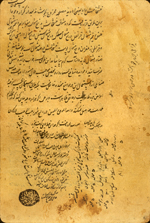Catalogue: Pharmaceutics
-
 Risālah-i afyūn (MS P 15)
Risālah-i afyūn (MS P 15) - (Essay on Opium)
- رساله افيون
- by ‘Imād al-Dīn Maḥmūd ibn Mas‘ūd Shīrāzī (fl. mid 16th century)
- عماد الدين محمود ابن مسعود شيرازى
‘Imād al-Dīn Maḥmūd ibn Mas‘ūd Shīrāzī studied medicine with his father in Shiraz and taught a number of students himself. Early in his career he was in the service of the governor of Shirvan, during which time he incurred the governor's wrath, for which he received the punishment of spending one night outdoors in the cold and snow. ‘Imād al-Dīn Maḥmūd ibn Mas‘ūd Shīrāzī resorted to opium during that night, and, although he recovered from the immediate effects of the cold, he had a tremor for the rest of his life. He became an opium-eater (afyūni), convinced of the therapeutic value of opium.
Reflecting his own experience, ‘Imād al-Dīn Maḥmūd ibn Mas‘ūd Shīrāzī wrote a treatise in Persian on the medical and addictive properties of opium and its use in compound remedies. The National Library of Medicine has a copy of this treatise that was made in Kirman in the month of Rajab 999 [= April-May 1591], possibly during the author's lifetime or shortly thereafter. It appears to be the earliest recorded copy.
For other copies, see Storey PL II,2, p. 242 no. 411(1); Keshavarz, "Wellcome", pp. 324-5 no. 171.
Risālah-i afyūn (MS P 15)
Illustrations
The final page of a treatise on the medicinal uses of opium by ‘Imād al-Dīn Maḥmūd ibn Mas‘ūd Shīrāzī (fl. mid-16th century). According to the colophon, written diagonally alongside the bottom 9 lines of text, the copy was completed in the city of Kirman in the month of Rajab 999 (= April-May 1591). The copyist is not named. It is possible that this copy was made during the author's lifetime or shortly thereafter. At the bottom left of the page there is the impression of an undated oval owner's stamp which reads: al-hakīm ('doctor') and al-Qur ..[?]. There are also recipes written vertically at the lower right.
Physical Description
Persian. 70 leaves (fols. 1b-70b). Dimensions 18.5 x 11.7 (text area 13 x 6.5); 15 lines per page. The title Risālah-i afyūn is supplied by cataloguer; the subject of the treatise is evident on folio 1b. The author's name is given (folio 1b lines 9-10) as: Maḥmūd ibn Mas‘ūd Shīrāzī.
The copy is dated in colophon (folio 70b, written diagonally alongside lines 10-18), where it says that is was copied in Kirman in the month of Rajab 999 (= 25 April-24 May 1591); the scribe is not named. The copy may have been made during the author's lifetime or shortly thereafter.
The text is written in a small ta‘liq script in black ink with headings in red and red overlinings. There are catchwords.
There are some marginalia and marginal corrections. The folios are numbered with Arabic numerals.
The beige, glossy, paper is fairly thick and opaque, with laid lines only visible. The edges have been trimmed from their original size. Folio 50 has a large hole in the center that has been filled with blank paper.
The volume consists of 70 leaves. Folio 1a is blank except for owner's notes and stamp.
Binding
The volume is bound in soft brown leather with blind-tooled frames on both covers. There are no pastedowns or endpapers.
Provenance
There is an owner's stamp on folio 70b (undated with unclear name except for hakim). The same stamp is found on folio 1a, along with the faint impression of a different owner's stamp.
The volume was in the collection of the Army Medical Library in 1946; no further information is available on the provenance.
References
Schullian/Sommer, Cat of incun. & MSS., entry P 15, p. 334, where the author is given as ‘Mahmud ibn Mas‘ud the physician (al-tabib)'.
NLM Microfilm Reel: FILM 48-134 no. 3











